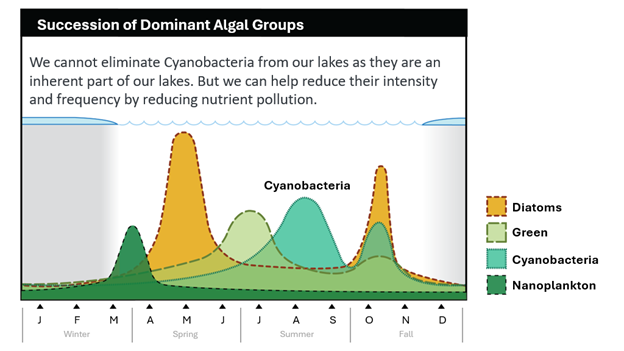What’s the deal with algae?
Webinar teaches about vital role it plays in aquatic ecosystems and about some types of algae that may cause problems in Michigan.

Did you know there are many different kinds of algae? Algae form the foundation of aquatic food webs that provide food for invertebrates, fish and other organisms, keep our aquatic systems oxygenated and also provide many products for human use.
What impacts algal growth?
Algae are a natural and integral part of aquatic ecosystems, but when ecosystems are unbalanced with excess nutrients or a lack of rooted aquatic plants, they can become a nuisance. This is what most people see. Algae known as cyanobacteria can produce toxins and are considered harmful algal blooms (or HABs). Algae growth is impacted by the concentration of phosphorus and nitrogen. Light, temperature and water quality can also impact algal growth. If you watch your lake closely, you will notice that different types of algae dominate at different times of the year (see Figure 1). In many lakes, nanoplankton dominate in early spring, diatoms in mid- to late spring with green algae and bluegreen algae dominating in the hot summer months. Diatoms often return to dominance in the fall and can continue to dominate during the winter months.

Green filamentous algae are some of the more commonly seen types of algae and are sometimes mistaken for a harmful algal bloom because of their bright green color. Unlike a harmful algal bloom, filamentous algae can be picked up with a stick. Filamentous algae can become a nuisance when it washes up on beaches as algal mats can include E. coli or Salmonella. This happened along Lake Michigan beaches in 2012, as described in an online article.
Learn about algae's vital role
Michigan Sea Grant and partners hosted a free online webinar all about algae, the tiny living things at the foundation of aquatic food webs. In the webinar you will learn about algae’s vital role in aquatic ecosystems and get to know didymo, Cladophora, and other types of algae that can cause problems here in Michigan. This webinar is for people impacted by algae in the Great Lakes or inland waters or anyone who wants to learn more about this topic.
More about HABS
If you are interested in learning more about harmful algal blooms, watch this HABS 101 webinar online or visit the online resources page.
Michigan Sea Grant helps to foster economic growth and protect Michigan’s coastal, Great Lakes resources through education, research and outreach. A collaborative effort of the University of Michigan and Michigan State University and its MSU Extension, Michigan Sea Grant is part of the NOAA-National Sea Grant network of 34 university-based programs.
This article was prepared by Michigan Sea Grant under award NA22OAR4170084 from the National Oceanic and Atmospheric Administration, U.S. Department of Commerce through the Regents of the University of Michigan. The statement, findings, conclusions, and recommendations are those of the author(s) and do not necessarily reflect the views of the National Oceanic and Atmospheric Administration, the Department of Commerce, or the Regents of the University of Michigan.



 Print
Print Email
Email

